coolant level Oldsmobile Cutlass Supreme 1995 Owner's Manuals
[x] Cancel search | Manufacturer: OLDSMOBILE, Model Year: 1995, Model line: Cutlass Supreme, Model: Oldsmobile Cutlass Supreme 1995Pages: 340, PDF Size: 16.68 MB
Page 119 of 340
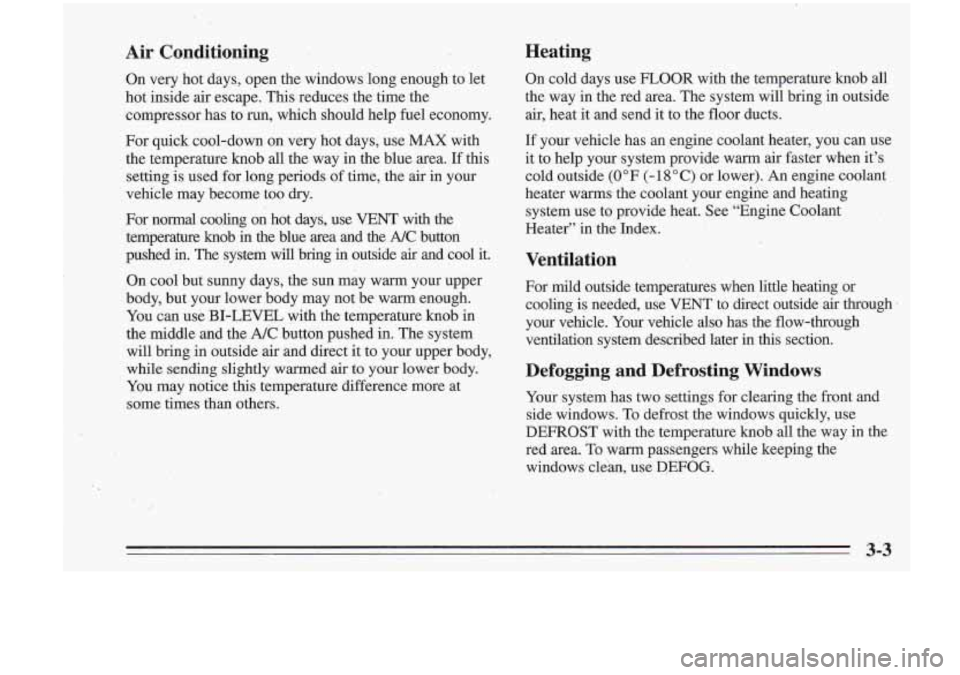
Air Conditioning
On very hot days, open the windows long enough to let
hot inside air escape. This reduces the time the
compressor has to run, which should help fuel economy.
For quick cool-down on very hot days, use
MAX with
the temperature knob all the way in the blue area. If this
setting is used. for long periods of time, the air in your
vehicle may become too dry.
For normal cooling on hot days, use
VENT with the
temperature knob
in the blue area and the NC'button
pushed
in. The system will bring in outside air and cool it.
On cool but sunny days, the sun may warm your upper
body, but your lower body may not be warm enough.
You can use BI-LEVEL with the,terhperature
knob in
the middle and the
A/C button pushed in. The system
will bring
in outside air and direct it to your upper body,
while sending slightly warmed
air to your lower body.
You may notice this temperature difference more at
. '
some times than others.
J
Heating
On cold days use FLOOR with the temperature knob all
the way
in the red area. The system will bring in outside
air, heat it and send it to the floor ducts.
If your vehicle has an engine coolant heatkr, you can use
it to help your system provide warm air faster when it's
cold outside
(0" F (-1 8 O C) or lower). An engine coolant-
heater
warms the coolant your engine and heating
system use to provide heat. See "Engine Coolant
Heater" in the Index.
Ventilation
For mild outside temperatures when little heating or
cooling is needed, use
VENT to direct outside air through
your vehicle. Your vehicle also has the flow-through
ventilation system described later in this section.
Defogging and Defrosting Windows
Your system' has two settings for clearing the front and
side windows. To defrost the windows'quickly, use
DEFROST with the temperature knob all the way in the
red area. To warrn passengers while keeping the
windows' clean, use
QEFOG.
3-3
Page 187 of 340
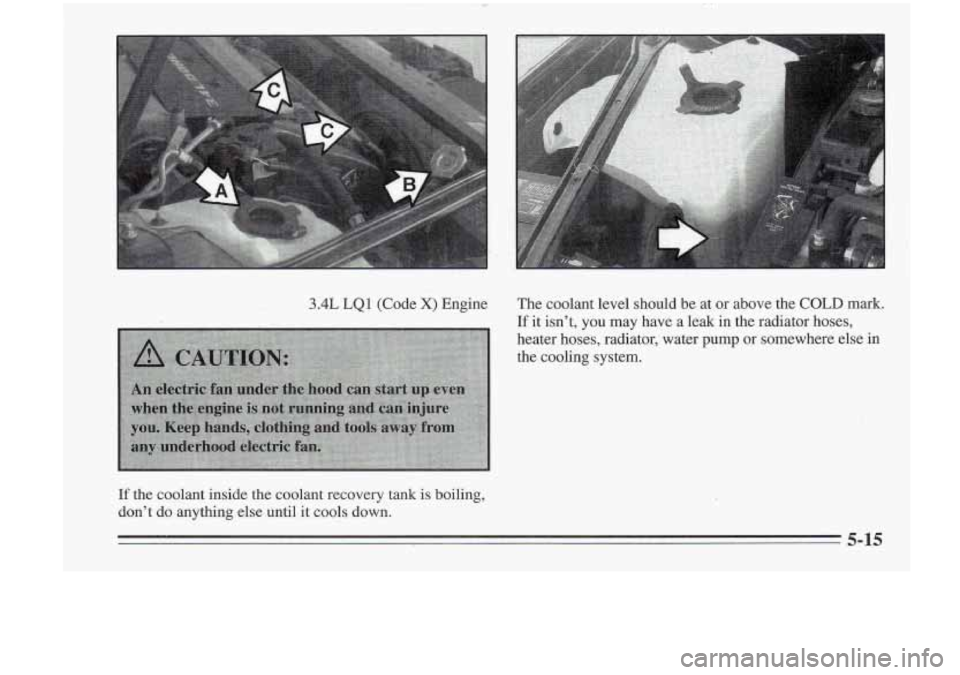
3.4L LO1 (Code X) Engine Y The coolant level should be at or above the COLD mark.
If it isn’t, you may have a leak in the radiator hoses,
heater hoses, radiator, water
pump or somewhere else in
the
cooling system.
If the coolant inside the coolant recovery tank is boiling,
don’t do anything else (until it
cools down.
5-15
Page 188 of 340
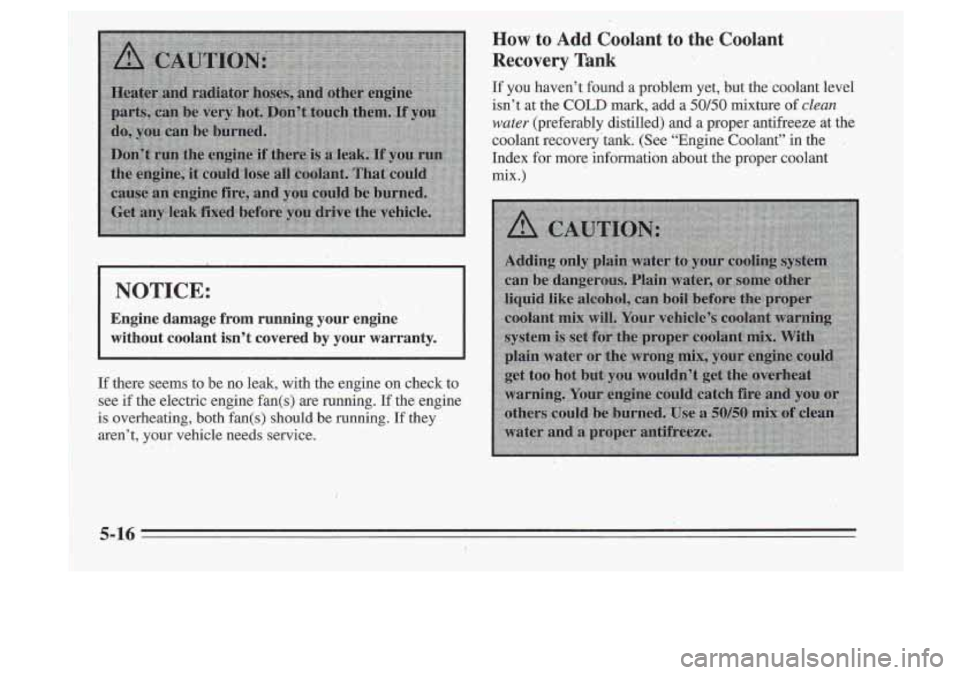
NOTICE:
Engine damage from running your engine
without coolant isn’t covered
by your warranty.
If there seems to be no leak, with the engine on check to
see if
the electric engine fan(s) are running. If the engine
is overheating, both fan(s) should be running. If they
aren’t, your vehicle needs service.
How to Add Coolant to the Coolant
Recovery Tank
If you haven’t found a problem yet, but the’coolant level
isn’t at the
COLD mark, add a 50/50 mixture of clean
water (preferably distilled) and a proper antifreeze at the
coolant recovery ‘tank. (See “Engine Coolant” in the
Index for more information about the proper coolant
mix
.)
5-16
Page 193 of 340
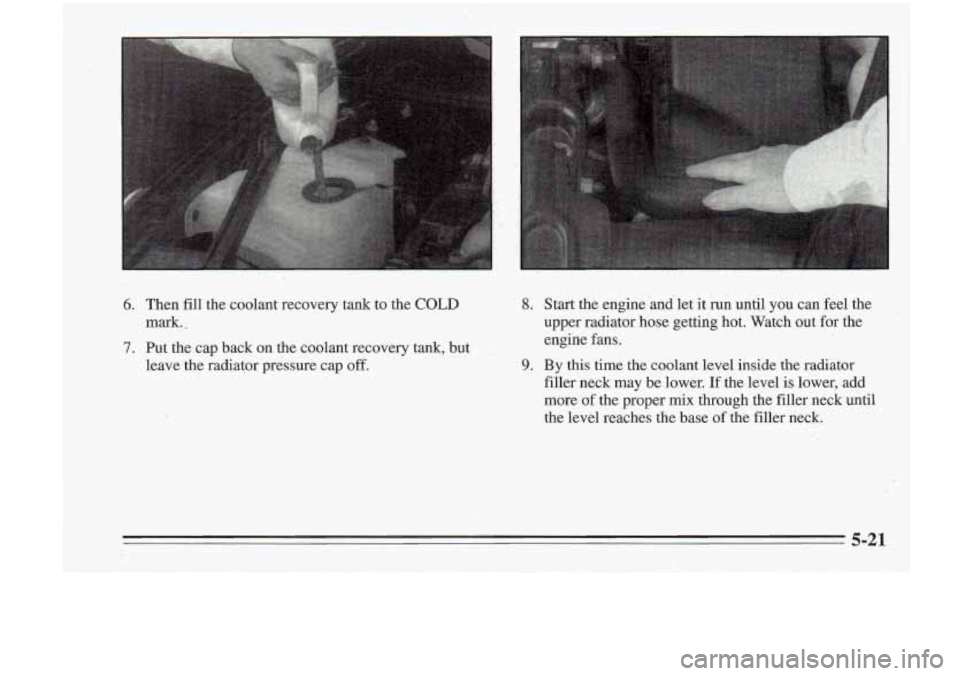
6. Then fill the coolant recovery tank to the COLD
7. Put the cap back on the coolant recovery tank, but
mark.
-
leave the
radiator pressure cap off.
8. Start the engine 'and let it run until you can feel the
upper radiator hose getting hot. Watch out for the
engine fans.
filler neck may be lower. If the level
is lower, add
more of the proper
mix through the filler neck until
the level reaches the base of the filler neck.
9. By this time the coolant level inside the radiator
5-21 ~.
Page 194 of 340
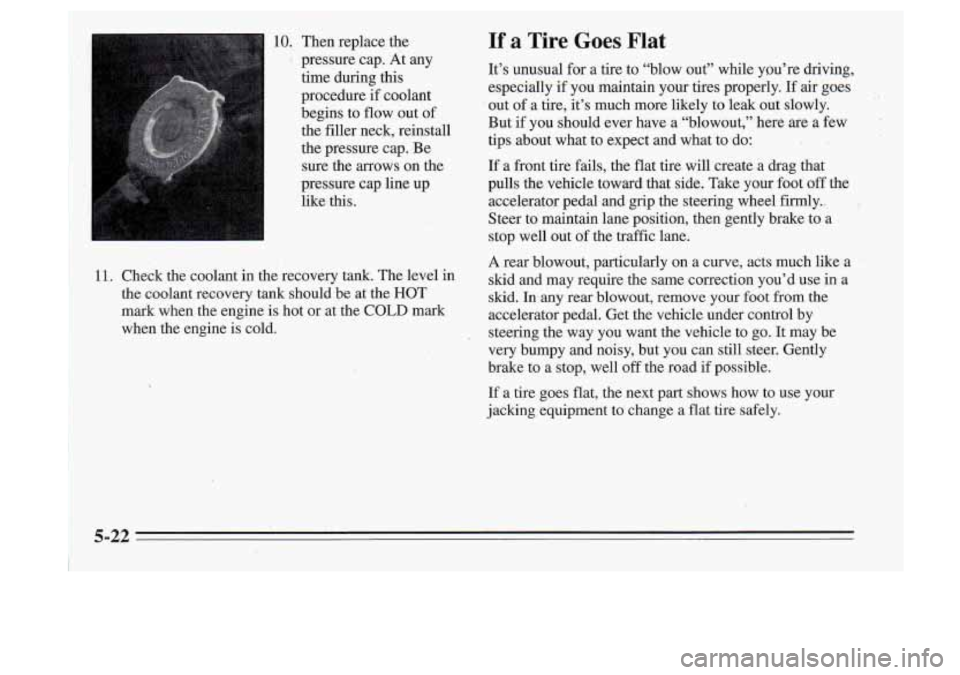
10. Then replace the
’ pressure cap. At any
time during this
procedure if coolant
begins to flow out of
the filler neck, reinstall
the pressure cap. Be
sure the arrows on the
pressure cap line up
like this.
11. Check the coolant in the recovery tank. The level in
the coolant recovery tank should be at the HOT
mark when the engine
is hot or at the COLD mark
when the engine
is cold.
If a Tire Goes Flat
It’s unusual for a tire to “blow out” while you’re \
driving,
especially
if you maintain your tires properly. If air goes
out
of a tire, it’s much more likely to leak out slowly.
But if you should ever have a “blowout,” here are a few
tips about what to expect and what to do:
If a front tire fails, the flat tire will create a drag that
pulls the vehicle toward that side. Take your foot
off the
accelerator pedal and grip the steering wheel firmly.,
Steer to maintain lane position, then gently brake to a
stop well out of the traffic lane.
A rear blowout, particularly on a curve, acts much like a
skid and may require the same correction you’d use in a
skid. In any rear blowout, remove your foot from the
accelerator pedal. Get the vehicle under control by
steering the way you want the vehicle to go.
It may be
very bumpy and noisy, but you can still steer. Gently
brake to a stop, well
off the road if possible.
If a tire goes flat, the next part shows how to
use your
jacking equipment to change a flat tire safely.
Page 224 of 340
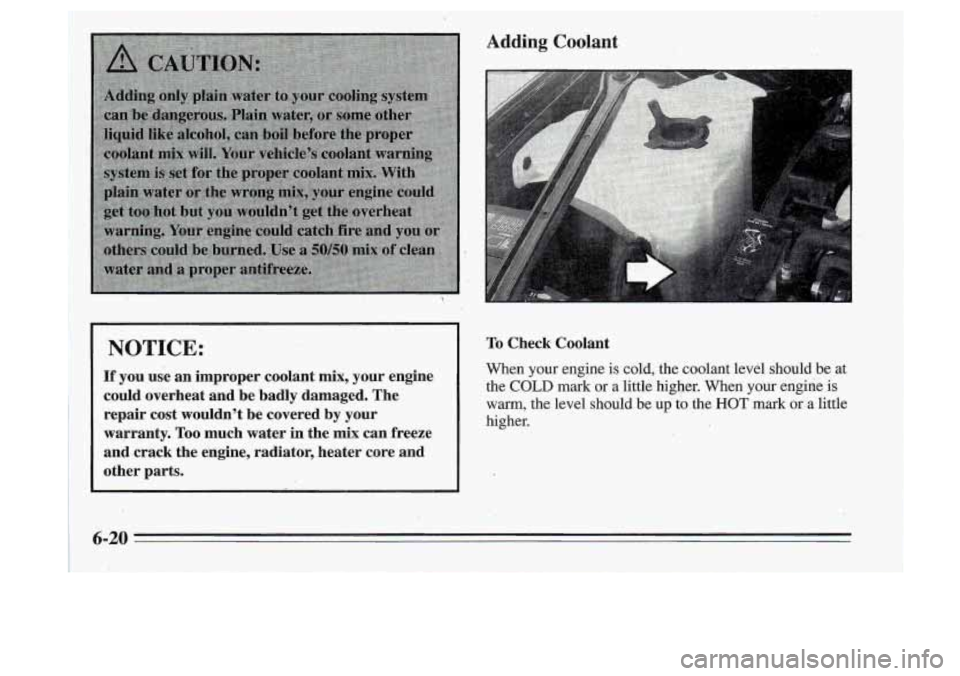
NOTICE:
~f you use an improper coolant mix, your engine
could overheat and be badly damaged. The repair cost wouldn’t be covered by your
warranty. Too much water in the mix can freeze
and crack the engine, radiator, heater core and
other parts.
..
To Check Coolant
When your engine is cold, the coolant level should be at
the
COLD mark or a little higher. When your engine is
warm, the level should be up to the HOT mark or a little
higher.
4-20
Page 306 of 340
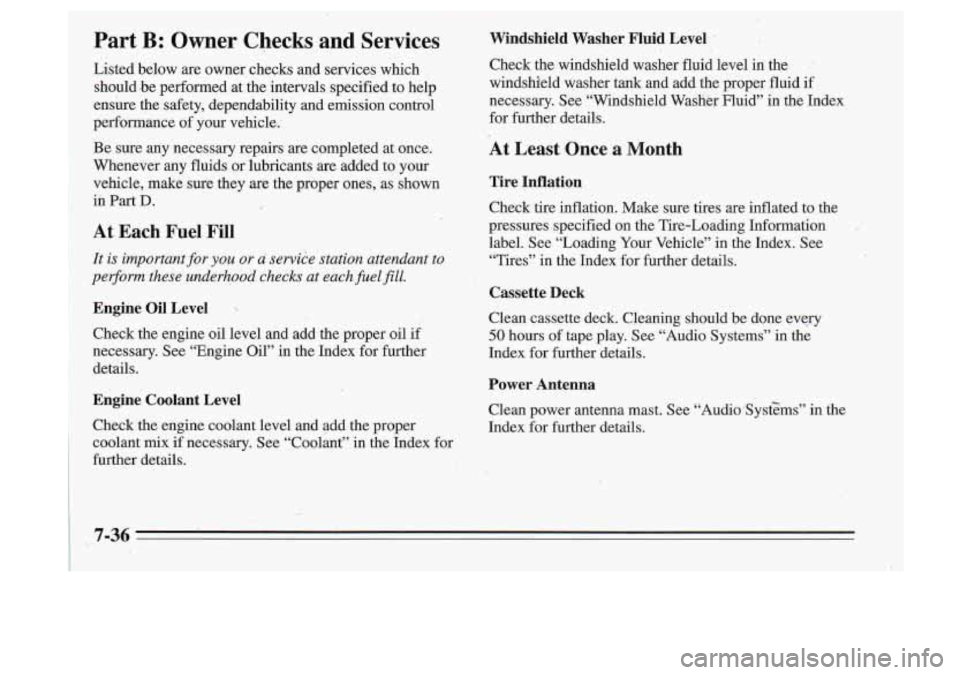
~ Part B: Owner Checks and Services Windshield Washer Fluid Level
Listed below are owner checks and services which
Check the windshield washer fluid level in the
should
be performed at the intervals specified to help windshield washer tank and add the proper fluid if
ensure the safety, dependability and emission control
necessary.
See “Windshield Washer Fluid” in the Index
performance of your vehicle. for further details.
Be sure any necessary repairs are completed at once.
Whenever any fluids or lubricants are added to your vehicle, make sure they are the proper ones, as shown
in Part
D.
’ At Each Fuel Fill
It is important for you or a service station attendant to
perform these underhood checks at each fuel
fill.
Engine Oil Level
Check the engine oil level and add the proper oil if
1 necessary. See “Engine Oil” in the Index for further
details.
Engine Coolant Level
Check the engine coolant level and add the proper coolant mix
if necessary. See “Coolant” in the Index for
further details.
At Least Once a Month
Tire Inflation
Check tire inflation. Make sure tires are inflated to the
pressures specified on the Tire-Loading Information
label.
See “Loading Your Vehicle” in the Index. See
“Tires” in the Index for further details.
Cassette Deck
Clean cassette deck. Gleaning should,be done every
50 hours of tape play. See “Audio Systems” in the
Index for further details.
Power Antenna
Clean power antenna mast. See “Audio*Syst$ms” in the
Index for further details.
Page 331 of 340
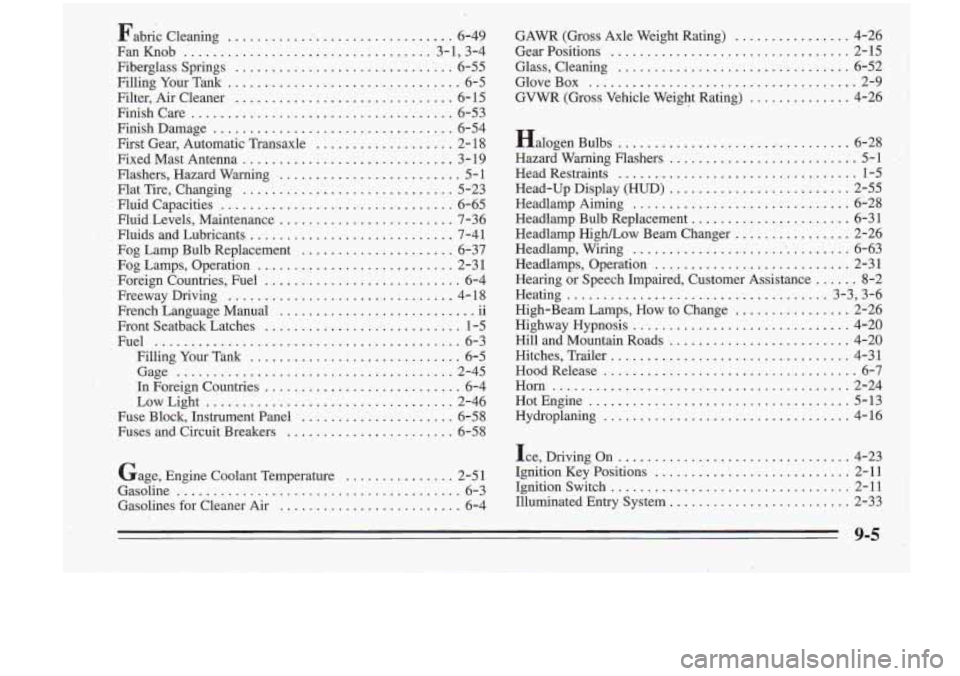
Fib& Cleaning ............................... 6-49
FanKnob
.................................. 3.1. 3.4
Fiberglass Springs
............................... 6-55
Filling Your Tank
... ............................ 6-5
Filter. Air Cleaner
.............................. 6- 15
Finishcare
.................................... 6-53
Finish Damage
................................. 6-54
First Gear. Automatic Transaxle
................... 2-18
FixedMastAntenna
............................. 3-19
Flashers. Hazard Warning
......................... 5-1
Flat Tire. Changing
............................. 5-23
Fluid Capacities
................................ 6-65
Fluid Levels. Maintenance
........................ 7-36
Fluids
and Lubricants ............................ 7-41
Fog Lamp Bulb Replacement
....................... 6-37
Fog -Lamps. Operation
........................... 2-3 1
Foreign Countries. Fuel ....... ................... 6-4
Freeway Driving
............................... 4- 18
French Language Manual
11
Front Seatback Latches ........................... 1-5
Fuel
.......................................... 6-3
Filling Your Tank
............. : ............... 6-5
Gage
...................................... 2-45
In Foreign Countries ........................... 6-4
Fuse Block, Instrument Panel
..................... 6-58
Fuses and-Circuit Breakers
................. ....... 6-58
.. ...........................
LowLight ................................... 2-46 GAWR
(Gross Axle Weight Rating)
................. 4-26
Gear Positions
................................. 2-15
Glass. Cleaning
................................ 6-52
Glove Box
...................................... 2-9
GVWR
(Gross Vehicle Weight Rating) .............. 4-26
Halogen Bulbs
................................. 6-28
Hazard Warning Flashers
.......................... 5-1 .
Head Restraints ................................. 1-3
Head-Up Display
(HUD) ......................... 2-55
Headlamp Aiming
.............................. 6-28
Headlamp Bulb Replacement
...................... 6-31
Headlamp HighLow Beam Changer
................ 2-26
Headlamp. Wiring
............................... 6-63
Headlamps. Operation
........................... 2-31
Hearing or Speech Impaired. Customer Assistance
...... 8-2
Heating
....................................... 3-3., 3-6
High-Beam Lamps. How to Change
....... .. ........ 2-26
Highway Hypnosis
............................... 4-20
Hill and Mountain Roads
......................... 4-20
Hitches, Trailer
................................. 4-31
Hood Release
................................... 6-7
Horn ......................................... 2-24
HotEngine
.................................... 5-13
Hydroplaning
.................................. 4-16
Ice. Driving On
................................ 4-23
Gasoline
....................................... 6-3 Ignition Switch 2-11
Gasolines for Cleaner
Air ......................... 6-4 Illuminated Entry System 2-33
Gage.
Engine Coolant Temperature
............... 2-51 Ignition Key Positions ........................... 2-11
.................................
.........................
9-5
'I